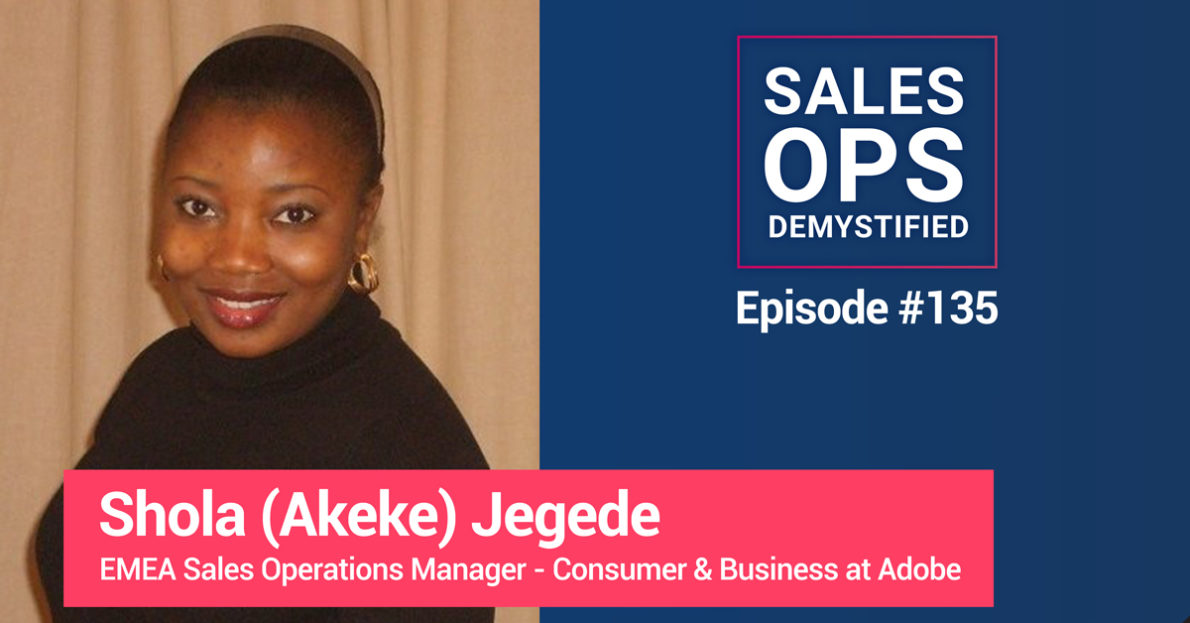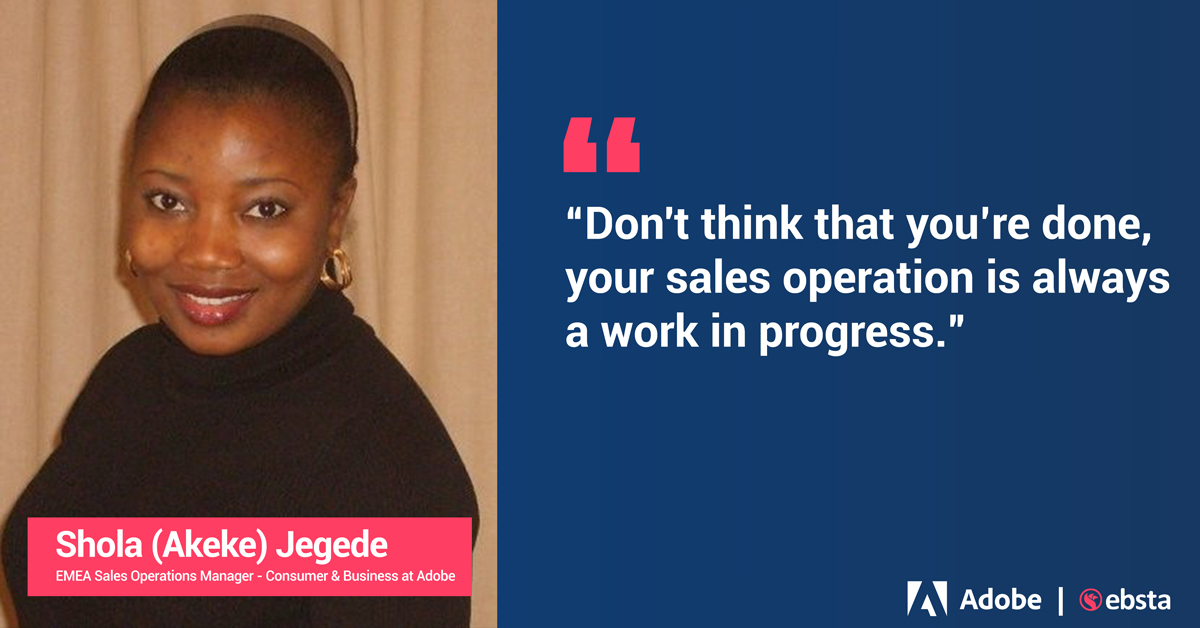
EMEA Sales Operations Manager – Shola Jegede of Adobe
Shola Jegede, Sales Operations Manager of Adobe, jumped onto the Sales Ops Demystified podcast to share her journey and experience in sales operations. Check out all the other episodes of Sales Operation Demystified here
Connect with Shola and Adobe here:
Tools Mentioned:
Key Takeaways
Shola’s journey into sales ops…
Shola has a degree in computer science and then got a second degree related to the field of business. She was always interested in using data to increase business and wanted to focus on that part of the work. She started working in sales ops at Microsoft and found that the shift suited her a lot. She enjoys working with data and using it to help guide operations and build processes to support the sales team. Currently, she is working as a sales operations manager at a regional level at Adobe.
Adobe’s sales tech stack
Of course, Adobe is a large company, so it has to be divided into many divisions. Shola’s department covers the document and creative cloud, and the team consists of six sales operations managers who manage a group of about 120 sales reps.
As for their tech stack, Shola says they use Salesforce just like most other businesses do. In addition to that, they make use of Tableau for mapping insights and also have the entire Office stack. They also make use of Gabia.
The biggest challenges in remote work
Shola points out an issue that affects many employees but is not often raised: the issue of working from home for employees with children. She herself has school-age children, and so do some team members, including her own manager. As she says, the initial few months were very stressful, with lockdown situations across the globe and children having to stay at home all day while parents tried to work in the same environment with no childcare services available.
However, she gives credit to Adobe as a company and her team for being very supportive of each other and understanding the issues being faced by parents who are working. Shola says she is hopeful that the worst of that time would have passed as most schools have reopened, and people who are working from home now have more of a system set in place.
The impact of remote work on culture
Shola tells us that the team did not bring any changes to the tech they are using, but a cultural shift to working remotely was felt throughout the company. They began to refocus their energy away from processes that were not as helpful and focused on those avenues, which gave them a positive response.
The pandemic has changed the way people do business. For Adobe, some digital transformations that they had been planning for years got fast-tracked, which has helped them in their day-to-day work. Shola feels that customers and even sales teams will find some of these changes beneficial even after the pandemic ends. In contrast, some changes would be evolved further to match whatever the landscape is after the epidemic ends.
Changing targets and indicators for work during the pandemic
Due to the substantial effect businesses suffered during the pandemic, Shola says that the team modified their targets and goals due to the epidemic. Based on the first two quarters’ response, Shola says they recently adjusted targets for the third quarter to make up for losses. As she says, it’s essential to be flexible in hard times, and modify according to the situation.
Is it possible to forecast accurately?
With the uncertain nature of the economy, there were challenges in forecasting accurately.
Forecasting at Adobe is a team effort. The day to day running for her region is done by Shola. For data over the long term, her colleagues build exponential models to track the rates and big deals being done, with Shola giving input based on patterns she sees from older data.
These last two quarters, due to COVID, were challenging forecasting as historical data did not apply to them, so Shola took help by taking consistent feedback from clients and the sales team to get a feeling for the forecast. Shola says they had some surprises during this period though she happily notes that many of these have been good surprises. Many people at the start of the pandemic were very cautious, and there was an idea that all businesses would be badly affected. However, the company has done better than they had imagined at that time, and Shola feels that things are going in the right direction now.
#1 sales metrics: annual recurring revenue & deal registration ratio
Shola gives us many options, starting with the Annual Recurring Revenue, which she says is what every business looks at. Beyond that, she likes to focus on the deal registration ratio, a process where they note the number of deals taken up by the company’s partners. In the long run, an increase or decrease in the number of deals registered by the partners will show an effect in the pipeline for the sales teams. Another metric that she tracked a lot during this pandemic was the conversion rate of quotes given by partners that turn into meetings with customers. Again, these show how likely deals are to occur in the long run.
Due to the pandemic, the company has started paying attention to the Average Revenue Per User. This lets them keep a balance between doing what is best for the customers while keeping the company’s business needs in mind.
Shola’s biggest influences:
- Juliette Lavery – Former Sales Operations Manager at Microsoft
- Stuart Gale – Business Performance and Operations Lead at Adobe
Who in the world of sales ops…. would Shola want to take out for lunch?
Ian Turnbull – Sales Operations Manager at Adobe
Subscribe To Sales Ops Demystified:
Quote:

Table of Contents
Share this article
Sign up for Insights
Learn from the brightest minds how to predictably and efficiently grow revenue.
Related Content
Why 69% of Workers Don’t Engage & How Revenue Leaders Can Fix It
In this episode of Revenue Insights, host Adam Roberts sits down with Greg Leos, Payments Division Leader at Weave, to examine the growing trust gap between employers and employees and why it’s become a business-critical challenge for leaders in today’s workplace. With employee engagement at a decade-low and corporate leadership facing unprecedented scrutiny, Greg draws…
How High-Growth Companies Nail Sales Qualification
Want to transform your sales qualification process and close more deals? Join host Guy Rubin in this Revenue Insights greatest hits compilation, featuring standout moments from conversations with top revenue leaders at EDB, Matium, and Popl. This special episode dives deep into proven qualification methodologies like MEDDIC and Acxiom Sales Kinetics, and explores how successful…
Why Only 1 in 5 Reps Hit Quota, And How Data-Driven Leaders Fix It | Dieter Heren
In this episode of Revenue Insights, host Adam Roberts sits down with Dieter Heren, Vice President of Sales at Popl, to unpack the evolving role of revenue operations in today’s AI-first sales environment. Drawing on his rare transition from RevOps to frontline sales leadership, Dieter brings a tactical yet strategic lens to building high-performing teams…